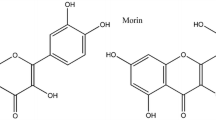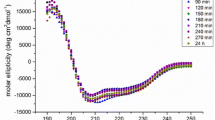Abstract
Colchicine (Col), a naturally occurring alkaloid, has been used as an anti-inflammatory, anti-fibrotic, and anti-tumor drug. The present study reports in vitro interaction between Col and hen egg white lysozyme (HEWL) by spectroscopy, isothermal titration calorimetry (ITC), and molecular docking techniques. The fluorescence results indicated that Col quenches the intrinsic fluorescence of HEWL through static quenching mechanism which is also substantiated by UV–visible spectroscopy. The average distance (r) between donor (HEWL) and acceptor (Col) was evaluated by Förster’s resonance energy transfer theory. Thermodynamic parameters obtained from ITC suggested that hydrophobic interaction plays a major role in the complex formation, and it is an entropically driven process. Col altered the secondary structure of HEWL revealed by circular dichroism which is further corroborated by synchronous, 3D fluorescence and FTIR techniques. In addition, molecular docking was employed to find out binding site of Col on HEWL and amino acid residues involved in the binding process. This study is expected to provide insights into the type of interaction and binding mechanism of Col with HEWL.








Similar content being viewed by others
References
Roy AS, Utreja J, Badhei S. Characterization of the binding of fisetin and morin with chicken egg lysozyme using spectroscopic and molecular docking methods. J Incl Phenom Macrocycl Chem. 2015;81:385–94.
Revathi R, Rameshkumar A, Sivasudha T. Spectroscopic investigations on the interactions of AgTiO2 nanoparticles with lysozyme and its influence on the binding of lysozyme with drug molecule. Spectrochim Acta A Mol Biomol Spectrosc. 2016;152:192–8.
Wang F, Sheng S, Ge X, Huang H, Ma QY. Exploring the interaction between milrinone drug and lysozyme by fluorescence spectroscopy and differential scanning calorimetry. J Therm Anal Calorim. 2018. https://doi.org/10.1007/s10973-018-7491-5.
Nguyen TL, Mcgrath C, Hermone AR, Burnett JC, Zaharevitz DW, Day BW, Wipf P, Hamel E, Gussio R. A common pharmacophore for a diverse set of colchicine site inhibitors using a structure-based approach. J Med Chem. 2005;48:6107–16.
Khatun S, Riyazuddeen. Interaction of colchicine with BSA: spectroscopic, calorimetric and molecular modeling approaches. J Biomol Struct Dyn. 2017. https://doi.org/10.1080/07391102.2017.1384397.
Sardar PS, Maity SS, Das L, Ghosh S. Luminescence studies of perturbation of tryptophan residues of tubulin in the complexes of tubulin with colchicine and colchicine analogues. Biochemistry. 2007;46:14544–56.
Mane JY, Klobukowski M, Huzil JT, Tuszynski J. Free energy calculations on the binding of colchicine and its derivatives with the α/β -tubulin isoforms. J Chem Inf Model. 2008;48:1824–32.
Hu Y, Liu Y, Zhao R, Qu S. Interaction of colchicine with human serum albumin investigated by spectroscopic methods. J Chem Inf Model. 2005;37:122–6.
Das L, Datta AB, Gupta S, Poddar A, Sengupta S, Janik ME. -NH-Dansyl isocolchicine exhibits a significantly improved tubulin-binding affinity and microtubule inhibition in comparison to isocolchicine by binding tubulin through its A and B rings. Biochemistry. 2005;44:3249–58.
Zhao Q, Xu X, Sun X, Liu M, Sun D, Li L. A calorimetric study on interactions of colchicine with human serum albumin. J Mol Struc. 2009;931:31–4.
Banerjee A, Kasmala LT, Hamel E, Sun L, Lee K. Interaction of novel thiocolchicine analogs with the tubulin isoforms from bovine brain. Biophys Res Commun. 1999;254:334–7.
Banerjee A. Differential effects of colchicine and its B-ring modified analog MTPT on the assembly-independent GTPase activity of purified β-Tubulin isoforms from bovine brain. Biochem Biophys Res Commun. 1997;231:698–700.
Bosca F, Tormos R. Behavior of drug excited states within macromolecules: binding of colchicine and derivatives to albumin. J Phys Chem B. 2013;117:7528–34.
Hu Y, Liu Y, Zhang L, Zhao R, Qu S. Studies of interaction between colchicine and bovine serum albumin by fluorescence quenching method. J Mol Struc. 2005;750:174–8.
Wen W, Tan Y, Xiong H, Wang S. Voltammetric and spectroscopic investigations of the interaction between colchicine and bovine serum albumin. Int J Electrochem Sci. 2010;5:232–41.
Vahidzadeh M, Gharanfoli M, Bakaeean B, Chamani J. Colchicine binding site determination in human multi-spectroscopic and zeta-potential techniques. Rom J Biochem. 2012;49:49–102.
Khatun S, Riyazuddeen, Yasmeen S, Kumar A, Subbarao N. Calorimetric, spectroscopic and molecular modelling insight into the interaction of gallic acid with bovine serum albumin. J Chem Thermodyn. 2018;122:85–94.
Millan S, Satish L, Kesh S, Chaudhary YS, Sahoo H. Interaction of lysozyme with Rhodamine B: a combined analysis of spectroscopic & molecular docking. J Photochem Photobiol B Biol. 2016;162:248–57.
Das S, Rohman MA, Roy AS. Exploring the non-covalent binding behaviours of 7-hydroxyflavone and 3-hydroxyflavone with hen egg white lysozyme: multi-spectroscopic and molecular docking perspectives. J Photochem Photobiol B Biol. 2018;180:25–38.
Khatun S, Riyazuddeen, Qais FA. Characterization of the binding of triprolidine hydrochloride to hen egg white lysozyme by multi-spectroscopic and molecular docking techniques. J Mol Liq. 2018;269:521–8.
Wang G, Wang L, Tang W, Hao X, Wang Y, Lu Y. Binding of quercetin to lysozyme as probed by spectroscopic analysis and molecular simulation. J Fluoresc. 2011;21:1879–86.
Zhan M, Guo M, Jiang Y, Wang X. Characterization of the interaction between gallic acid and lysozyme by molecular dynamics simulation and optical spectroscopy. Int J Mol Sci. 2015;16:14786–807.
Akram M, Bhat IA, Anwar S, Kabir-ud-Din. Molecular interaction of an ester-functionalized biodegradable gemini surfactant with lysozyme : insights from spectroscopy, calorimetry and molecular docking. J Mol Liq. 2015;212:641–9.
Senthilkumar R, Marimuthu P, Paul P, Manojkumar Y, Arunachalam S, Eriksson JE, Johnson MS. Plasma protein binding of anisomelic acid: spectroscopy and molecular dynamic simulations. J Chem Inf Model. 2016;56:2401–12.
Aghili Z, Taheri S, Zeinabad HA, Pishkar L, Saboury AA, Rahimi A, Falahati M. Investigating the interaction of Fe nanoparticles with lysozyme by biophysical and molecular docking studies. PLoS ONE. 2016;11:e0164878.
Tian L, Hu X, Liu Z, Liu S. Studies on the interaction of heparin with lysozyme by multi-spectroscopic techniques and atomic force microscopy. Spectrochimica Acta A Mol Biomol Spectrosc. 2016;154:27–32.
Khatun S, Riyazuddeen. Probing of the binding profile of anti-hypertensive drug, captopril with bovine serum albumin: a detailed calorimetric, spectroscopic and molecular docking studies. J Chem Thermodyn. 2018;126:43–53.
Hosseinzadeh R, Khorsandi K, Hasani VS, Khatibi A. Biological interaction of thiamine with lysozyme using binding capacity concept and molecular docking. J Biomol Struc Dyn. 2016;34:2146–54.
Khatibi A, Keihan AH, Hasani VS. Bio thermodynamic studies of diclofenac interaction with lysozyme under various conditions using diclofenac-selective membrane electrode and molecular docking. J Biomol Struc Dyn. 2017;35:2789–93.
Li XR, Jia JJ, Yan YH, Ni TJ. Comparative studies on interactions of L-ascorbic acid, α-tocopherol, procyanidin B3, β-carotene, and astaxanthin with lysozyme using fluorescence spectroscopy and molecular modeling methods. J Food Biochem. 2016;41:e12338.
Ajmal MR, Chaturvedi SK, Zaidi N, Alam P, Zaman M, Siddiqi MK, Nusrat S, Jamal S, Mahmoud MH, Badr G, Khan RH. Biophysical insights into the interaction of hen egg white lysozyme with therapeutic dye clofazimine: modulation of activity and SDS induced aggregation of model protein. J Biomol Struc Dyn. 2017;35:2197–210.
Patial A, Verma P. Development of UV spectrophotometric method for estimation of colchicine in phosphate buffer saline pH 6.4. Int Res J Pharm. 2012;3:87–9.
Ajage RK, Kasture VS. Validated UV spectroscopic method for the estimation of three marker compounds in marketed polyherbal ayurvedic formulation. Der Pharm Lett. 2014;6:160–6.
Hemalatha K, Madhumitha G, Al-Dhabi NA, Arasu MV. Importance of fluorine in 2,3-dihydroquinazolinone and its interaction study with lysozyme. J Photochem Photobiol B Biol. 2016;162:176–88.
Sonu VK, Islam MM, Rohman MA, Mitra S. Lysozyme binding ability toward psychoactive stimulant drugs: modulatory effect of colloidal metal nanoparticles. Coll Surf B Biointerfaces. 2016;146:514–22.
Shanmugaraj K, Anandakumar S, Ilanchelian M. Probing the binding interaction of thionine with lysozyme: a spectroscopic and molecular docking investigation. Dyes Pigm. 2015;112:210–9.
Han R, Liu B, Li G, Zhang Q. Investigation on the interaction between lysozyme and cefepime hydrochloride by synchronous fluorescence and fluorescence quenching spectroscopy. Spectrosc Lett. 2016;49:225–30.
Hemalatha K, Madhumitha G, Ravi L, Khanna VG, Al-Dhabi NA, Arasu MV. Binding mode of dihydroquinazolinones with lysozyme and its antifungal activity against Aspergillus species. J Photochem Photobiol B Biol. 2016;161:71–9.
Roy S, Saxena SK, Mishra S, Yogi P, Sagdeo PR, Kumar R. Ecofriendly gold nanoparticles–Lysozyme interaction: thermodynamical perspectives. J Photochem Photobiol B Biol. 2017;174:284–90.
Jash C, Basu P, Payghan PV, Ghoshal N, Kumar GS. Chelerythrine–lysozyme interaction: spectroscopic studies, thermodynamics and molecular modeling exploration. Phys Chem Chem Phys. 2015;17:16630–45.
Yasmeen S, Riyazuddeen. Thermodynamics and binding mechanism of polyphenon-60 with human lysozyme elucidated by calorimetric and spectroscopic techniques. J Chem Thermodyn. 2017;110:79–86.
Ross PD, Subramanian S. Thermodynamics of protein association reactions: forces contributing to stability. Biochemistry. 1981;20:3096–102.
Jing M, Song W, Liu R. Binding of copper to lysozyme: spectroscopic, isothermal titration calorimetry and molecular docking studies. Spectrochim Acta A Mol Biomol Spectrosc. 2016;164:103–9.
Banipal TS, Kaur A, Khan IA, Banipal PK. Exploring thermodynamics and conformational aspects of nicotinic acid binding with bovine serum albumin: a detailed calorimetric, spectroscopic and molecular docking study. RSC Adv. 2016;6:34754–69.
Wang S, Peng X, Cui L, Li T, Yu B, Ma G, Ba X. Synthesis of water-soluble curcumin derivatives and their inhibition on lysozyme amyloid fibrillation. Spectrochim Acta A Mol Biomol Spectroscopy. 2018;190:89–95.
Fazili NA, Bhat IA, Bhat WF, Naeem A. Anti-fibrillation propensity of a flavonoid baicalein against the fibrils of hen egg white lysozyme: potential therapeutics for lysozyme amyloidosis. J Biomol Struc Dyn. 2016;34:2102–14.
Das S, Ghosh P, Koley S, Roy AS. Binding of naringin and naringenin with hen egg white lysozyme: a spectroscopic investigation and molecular docking study. Spectrochim Acta A Mol Biomol Spectrosc. 2018;192:211–21.
Das A, Thakur R, Dagar A, Chakraborty A. A spectroscopic investigation and molecular docking study on the interaction of hen egg white lysozyme with liposomes saturated and unsaturated phosphocholines probed by an anticancer drug ellipticine. Phys Chem Chem Phys. 2014;16:5368–81.
Feroz SR, Teoh YJ, Mohamad SB, Hong SL, Malek SNA, Tayyab S. Interaction of flavokawain B with lysozyme: a photophysical and molecular simulation study. J Lumines. 2015;160:101–9.
Kabir Z, Hamzah NAB, Ghani H, Mohamad SB, Alias Z, Tayyab S. Biophysical and computational characterization of vandetanib-lysozyme interaction. Spectrochim Acta A Mol Biomol Spectrosc. 2018;189:485–94.
Acknowledgements
Authors are thankful to the Chairman, Department of Chemistry, A.M.U, Aligarh, for providing the necessary facilities to carry out this research work. The PURSE and FIST grants from DST and SAP (DRS-II) grant from UGC, New Delhi are gratefully acknowledged. One of the authors (S.K.) gratefully acknowledge to UGC, New Delhi, for awarding Maulana Azad National Fellowship (MANF).
Author information
Authors and Affiliations
Corresponding author
Electronic supplementary material
Below is the link to the electronic supplementary material.
Rights and permissions
About this article
Cite this article
Khatun, S., Riyazuddeen A comprehensive calorimetric, spectroscopic, and molecular docking investigation to probe the interaction of colchicine with HEWL. J Therm Anal Calorim 136, 1757–1767 (2019). https://doi.org/10.1007/s10973-018-7800-z
Received:
Accepted:
Published:
Issue Date:
DOI: https://doi.org/10.1007/s10973-018-7800-z




